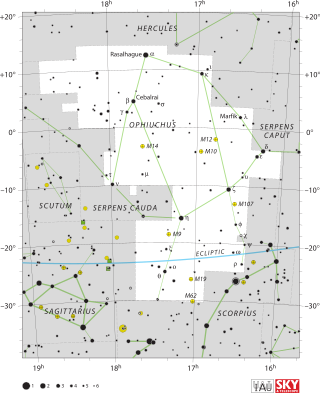Top Qs
Timeline
Chat
Perspective
Gamma Ophiuchi
Star in the constellation Ophiuchus From Wikipedia, the free encyclopedia
Remove ads
Gamma Ophiuchi, Latinized from γ Ophiuchi, also named Bake-eo,[9] is a fourth-magnitude star in the constellation Ophiuchus. Together with Beta Ophiuchi, it forms the serpent-holder's right shoulder.[10] The star is visible to the naked eye with an apparent visual magnitude of +3.75.[2] Based upon an annual parallax shift of 31.73 mas as seen from Earth, it is located 103 light-years from the Sun. It is moving closer to the Sun with a radial velocity of −7.6 km/s.[5]
Remove ads
Nomenclature
This star is known also as Muliphen,[11][12] although at least two more stars are known with this name: Gamma Canis Majoris (often spelled as Muliphein) and Gamma Centauri (often spelled as Muhlifain).[12] Muliphein is the IAU-approved name of Gamma Canis Majoris.[9]
This star has the Marshallese name Bake-eo (or Bake Eo, pronounced "bakey-yew"), which refers to the spondylus mussel. The IAU Working Group on Star Names approved the name Bake-eo for this star on 20 August 2024 and it is now so entered in the IAU Catalog of Star Names.[9]
In Chinese astronomy, β Ophiuchi and γ Ophiuchi form the asterism Zongzheng (宗正),[13] which was transliterated as Tsung Ching by R. H. Allen.[11]
Remove ads
Description
Image of the debris disk from the REASONS survey[14]
This is an A-type main sequence star with a stellar classification of A0 V.[3] Gray et al. (2003) lists a classification of A1VnkA0mA0,[4] indicating it is of type A1 V with the calcium K-line and metallic lines of an A0 star. It is approximately 184[7] million years old and is spinning rapidly with a projected rotational velocity of 220 km/s.[7] Gamma Ophiuchi has nearly three times the mass of the Sun and 1.8 times the Sun's radius.[15] The star shines with 29[3] times the luminosity of the Sun, which is being emitted from its outer atmosphere at an effective temperature of 9506 K.[3] It is radiating an excess emission of infrared, suggesting the presence of a circumstellar disk of dust at an orbital radius of 64 AU from the host star.[3] The disk was imaged in 2025.[14]
Remove ads
References
Wikiwand - on
Seamless Wikipedia browsing. On steroids.
Remove ads


